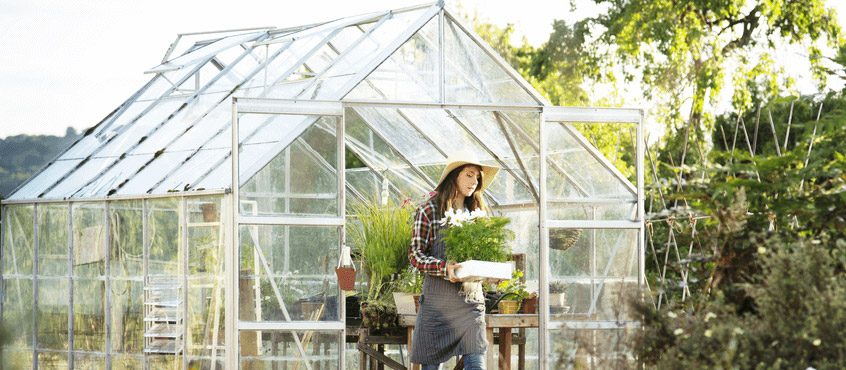Greenhouses that are fitted with horticultural glass allow far more natural light to enter than one built from polycarbonate or other materials, but unfortunately, this also makes them quite vulnerable due to the thinness of this type of glass.
In a place like the UK, with strong winds being an all too common occurrence, this fragile horticultural glass can be easily damaged by debris blown in those gales, and this is not good for any plants contained in the greenhouse that require a steady temperature or level of humidity to grow.
So, if you own this kind of greenhouse, it’s probably in your best interests to learn how to replace greenhouse glass for yourself, and it’s not as difficult as you might think.
Here is our step by step guide to repairing or replacing greenhouse glass panels.
Replacing greenhouse glass panes
If your greenhouse glass is broken and not just scratched, you’ll have to replace it. Whether you decide to replace it with another piece of glass immediately, or use carbon fibre or acrylic while you get the piece or pieces of glass you need, will depend on your own individual situation. Eventually though, you’ll have to replace it with horticultural glass, and here’s how to do it: –

- Step one is to make sure you’ve got the right protective clothing i.e. gloves and eye protectors, and then prepare the area before trying to remove the old panel. Put a large plastic sheet down on the ground below the broken glass, and check that no small shards or pieces of glass have fallen into any of the plant pots. Remove the plants from the area, to make space to work, and also to protect them from further possible harm.
- Remove the silicone sealant from around the glass pane. The best way to do this is to use a utility knife and just run it around the edges of the pane until the sealant is all gone.
- Once the sealant has all been removed, you need to also remove the fasteners that hold the pane in place. Now, the type of fastener will depend on the brand/type/etc. of greenhouse, but most of them are pretty easy to figure out, and shouldn’t cause you any problems.
Make sure you’re holding the glass (using safety gloves of course!) when you remove the clips just in case the glass is loose and falls. If it is still stuck in place, carefully work it loose and remove it, disposing of it in a safe place. - There might be some small pieces of glass still stuck to the frame, so you’ll need to remove these before doing anything else. A good way to do this is to use a small towel or rag.
UK’s Best mini greenhouse for tomatoes
6 Best Greenhouses Reviewed (UK)
Best Greenhouse Heaters
- With all the broken glass removed, you can now replace it with a new pane. Be very careful when you do this, and continue to wear your safety goggles and gloves. Line up the pane with the frame, and fix it in place using the fasteners/clips that came with the greenhouse. Now, use a silicone sealant gun around the edges of the pane.
- Finally, clean up the greenhouse, remove the plastic sheet and all broken glass, and then put the plants back in their rightful place.
Repairing cracks in greenhouse glass
If your glass pane is just cracked, and not broken, you could get away with just repairing the crack and not having to replace the pane. If this is the case…

- Remove the pane of glass by following the first three steps in the above section, but instead of disposing of the pane, do this-
- Lay a towel or thick sheet down on a table or workbench and place the cracked pane on top of it. Being very careful, clean the plane with a rag as we will be adding a solution to repair the crack and it’s best to have a clean surface to work with.
- Time to make up the solution that we will use to fill the crack. To do this, we need to mix one ounce of glycerin, water, and iron oxide in a small container. Make sure you mix the ingredients up well.
- Go back to the cracked panel and, using a soft cloth or rag, rub the solution into the scratch. You will need to keep rubbing continuously until the scratches are completely gone.
- Once the scratches are dealt with, you’ll need to clean the glass pane with some plain water and another cloth or rag, this time a dry one. You only need to use a little water, so please don’t overdo it.
- Once the pane is repaired, cleaned up, and dried off, you can put it back in the frame and use the fasteners and sealant gun to secure it place, and you’re done.
If you’re finding that you’re getting too many problems with horticultural glass breaking and scratching, you might want to consider replacing the glass with polycarbonate.
How to vent a Greenhouse
How to Grow in the Greenhouse All Year Round
Modern polycarbonate panels are much, much stronger than glass, and also much safer as it is far less likely to cut you if it does break.
Some of these panels come with UV filtering, which can be a good thing, and the insulation properties are only slightly lower than with horticultural glass, so it might be worth considering switching.
At the end of the day, it’s a personal choice. If I was being honest, I would say I prefer glass as I’m a bit of a traditionalist when it comes to greenhouses, but the practical part of me screams in my ear for not using polycarbonate panels every time it comes to repairing or replacing a glass panel.
Anyway, if you do stick with horticultural glass, you now know how to replace greenhouse glass, and even repair scratches to it. Let’s just hope you don’t have to do it too often.
